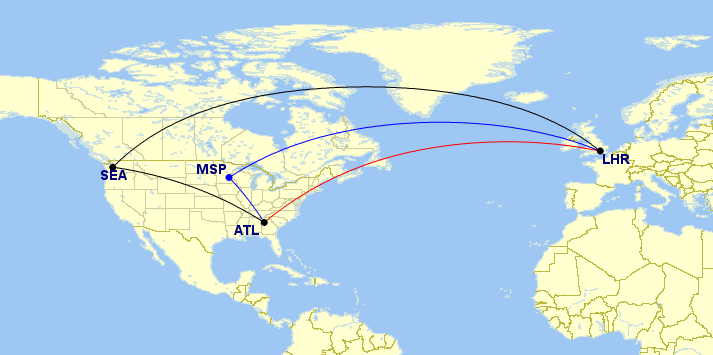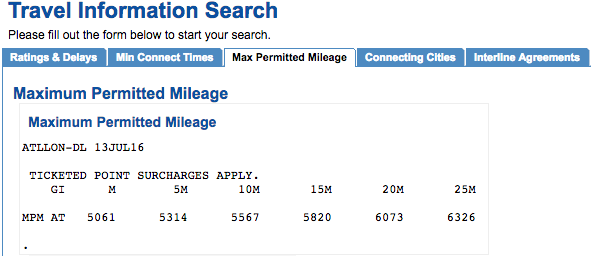I am finally getting around to writing up the award travel rules for using Delta SkyMiles. This completes my series on routing rules for the four U.S. airlines that still use a region-based redemption model. I’ve also started work on similar guides to international programs such as ANA Mileage Club, and there will be more of those to follow.
- Award Routing Rules on Alaska Airlines
- Award Routing Rules on American Airlines
- Award Routing Rules on Delta Air Lines
- Award Routing Rules on United Airlines
It may help when reading this post to keep in mind that Delta has five different award levels. All partner awards are priced at Level 1, the least expensive. Award travel on Delta may exist at all five levels. Typically there is more award space available at more expensive levels, but combining flights at different levels in a single award can be complicated. I recommend you read a post from One Mile at a Time that discusses this in great detail.
I also want you to keep in mind that award pricing and award routing rules are crucially interdependent. Rules exist so you can predict the price, and by looking at prices we can reverse engineer the rules. But Delta has taken several measures to make this process more opaque, creating uncertainty in the rules that I present here. Further comments and corrections are certainly welcome.
No Stopovers Permitted
Among several other changes made to the SkyMiles loyalty program in 2015, stopovers are no longer permitted on award tickets. You may still arrange a layover of up to 24 hours in connecting cities during international travel. That might be enough time for you to clear immigration and see some sights before getting on the next flight.
Open Jaws and One-way Travel
Delta prices all award tickets on a one-way basis, so there is usually no penalty or benefit to booking two one-way awards compared to a single round-trip award. It also means that you can easily book open jaws at the origin, destination, or both. Open jaws enable you to fly into one city and depart from another, covering the distance in between with a separate flight or ground transportation.
Sometimes it’s best to book awards in each direction as you find space rather than waiting for the entire trip to line up at once. On the other hand, you will be subject to twice as many reservation, change, and cancellation fees if you have separate tickets.
Most government taxes and other surcharges are also the same. However, be aware that Delta collects a surcharge on awards that originate from Europe. This would mean more fees for two one-way tickets (specifically on the return journey) compared to a round-trip award that originates in North America.
Blackout Dates
Three of Delta’s Asian partners have blackout dates for award travel, meaning you cannot book an award ticket at all — don’t even try searching for availability on these dates. You can find the most current dates by visiting the SkyMiles Terms & Conditions and expanding the menu to find the heading on “Blackout Dates.”
| Korean Air | |
|---|---|
| Within Korea | 1/1-1/3, 2/5-2/11, 2/27-3/1, 5/5-5/8, 6/3-6/6, 7/22-8/21, 9/13-9/19, 9/30-10/3, 12/31 |
| Departing Americas | 5/13-6/30, 12/9-12/25 |
| Departing Elsewhere | 1/1-1/3, 2/5-2/10, 7/15-8/21, 9/13-9/19, 12/21-12/31 |
| China Southern | |
| Europe to China | 3/18-3/26, 4/13-4/23, 6/25-8/30, 10/4-10/23, 12/8-12/23 |
| China to Europe | 2/2-2/15, 3/27-4/10, 4/17-4/28, 6/20-10/2, 10/17-10/28 |
| North America to China | 2/12-2/24, 5/12-6/30, 7/25-8/31, 10/4-10/14, 12/8-12/23 |
| China to North America | 1/2-1/15, 1/29-2/9, 6/24-9/4, 9/27-10/2 |
| Oceania to China | 1/1-1/5, 2/11-2/22, 6/19-6/27, 11/29-12/31 |
| China to Oceania | 1/1-3/2, 7/10-8/10, 9/27-10/5 |
| China Airlines | |
| All Regions (2015) | 1/1-1/4, 2/12-2/22, 6/1-8/31, 12/10-12/31 |
Although I have copied the dates for 2015/2016 above (China Airlines doesn’t have dates listed for 2016 … possibly a typo?), the list is extensive and subject to change. Suffice it to say that they can be a serious limitation. For example, blackout dates for domestic travel on Korean Air affect a few days or weeks in nearly every month of the year. You may also find it challenging to fly during any of the summer months on China Southern or China Airlines
Maximum Permitted Mileage
Not every airline follows a rule on maximum permitted mileage (MPM) when booking award travel, and it’s not a number that you can easily look up online for free. However, it is a concept worth knowing.
Delta’s routing rules generally permit you to get from A to B however you like, but you will have to keep the total distance of the journey within the MPM. Many sources report exceptions granted up to MPM + 5%. You can find the MPM using a paid service like ExpertFlyer (visit “Travel Information” in the left navigation menu). A five-day free trial is available if you don’t want to pay for access.
Here are the results for a sample search from Atlanta to London. The MPM is provided for one-way travel, so don’t overreact if you need to fly round-trip and find yourself drastically over the limit!
This table shows that the MPM on Delta between London and Atlanta is 5,061 miles, and with leeway of 5% (“5M”) you could probably travel as far as 5,314 miles.
You shouldn’t have to worry about MPM in most cases. The map below shows three possible itineraries between Atlanta and London. A non-stop journey is 4,201 miles, and connecting in Minneapolis would be a total of 4,921 miles. Both are well within the MPM. However, connecting in Seattle would require 6,982 miles, so even MPM + 5% is not enough to permit this path. It also adds hours to your journey; most people would avoid it.

Limited Connections and Transiting a Third Region
I have read some articles mentioning restrictions that Delta places on the number of connecting flights and their location. However, I have not found them substantiated by more than one source. These rules seem reasonable, but they also don’t seem necessary given the MPM limitation described above.
The first comment comes from MileCards, which suggests that Delta limits your options for transiting a third region on your way to the destination. The site only lists exceptions for travel originating in North America, and I have not found a similar list (for North America or other regions) on another site.
- Travel from North America to Africa may only connect in Europe
- Travel from North America to India may only connect in Europe or Asia
- Travel from North America to Australia may only connect in Asia
- Travel from North America to Asia may only occur via the Pacific Ocean
The second comment comes from FlyerTalk, which suggests that Delta places a limit of two connections each way (three flight segments) on travel within North America, and three connections each way (four flight segments) on intercontinental itineraries.
Regardless of the validity of these two rules, I don’t think most people will find them burdensome.
Married Segment Logic and Dynamic Pricing
These are pricing issues rather than routing rules, but they deserve mention because most people look at routing rules to determine if their itinerary will price correctly.
Most other programs say that as long as you travel between A and B while following their rules you will pay a certain published price. The best way to book is to look for award space on individual segments and then piece those same segments together as part of a longer itinerary that satisfies the award rules. Even though Delta doesn’t publish an award chart anymore, this chart still exists in theory because awards tend to match certain prices. Many people have taken screenshots of the old charts and have tracked changes to them since they were pulled.
Ultimately, this strategy relies on (1) clear rules for combining flights that have award availability and (2) a clear award chart with prices for that itinerary.
Married segment logic can get in the way of the first point. It essentially says that Delta may release different award space for every pair of cities even if you are making a connection. Here’s a practical example:
- Flight 101 from Seattle to Minneapolis will cost 12,500 miles (Level 1 award)
- Flight 102 from Minneapolis to Atlanta will cost 12,500 miles (Level 1 award)
- Booking these same flights to travel between Seattle and Atlanta will cost 20,000 miles (Level 3 award)
The price from Seattle to Atlanta would never change if this were another airline’s loyalty program because the award space is the same level and the type of award is the same: a domestic ticket within the continental U.S.
It may be that it won’t change on Delta, either, but at least it has the option to charge a different price for each origin/destination pair. It may decide that there’s more demand for travel between Seattle and Atlanta, so regardless of which particular flights you book it will charge more. This happens all the time with regular tickets that you buy with cash, and now Delta does the same when you redeem miles.
The second point, on clear pricing, is also obscured since Delta made an announcement last year that it would begin using dynamic pricing effective June 1, 2016. This uses factors like destination, demand, and other unnamed variables to adjust prices. How? We don’t know. Although Delta claims that most award prices will not change, it opens a very wide range of possibility.
At least married segment logic still follows that theoretical award chart. You’ll hit one of the five possible award prices for a given destination. Dynamic pricing ignores it completely. Bottom line: expect some unpredictability.

